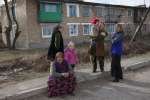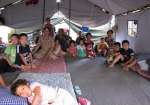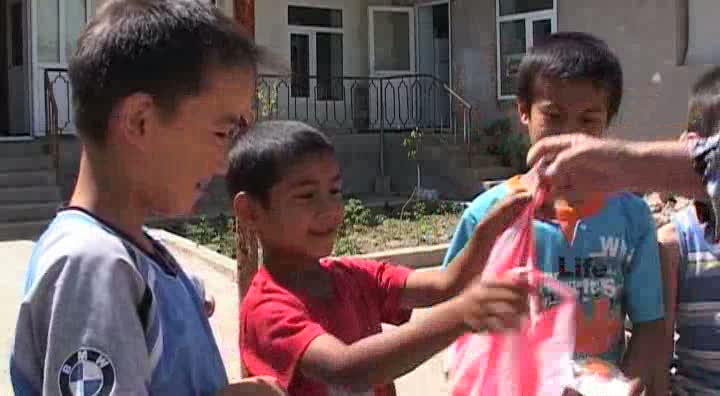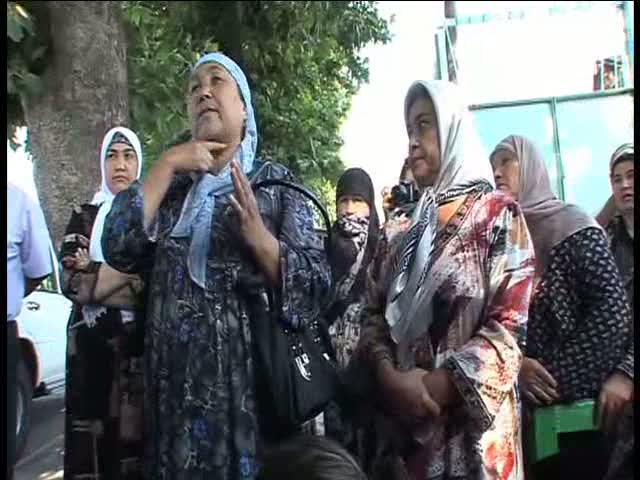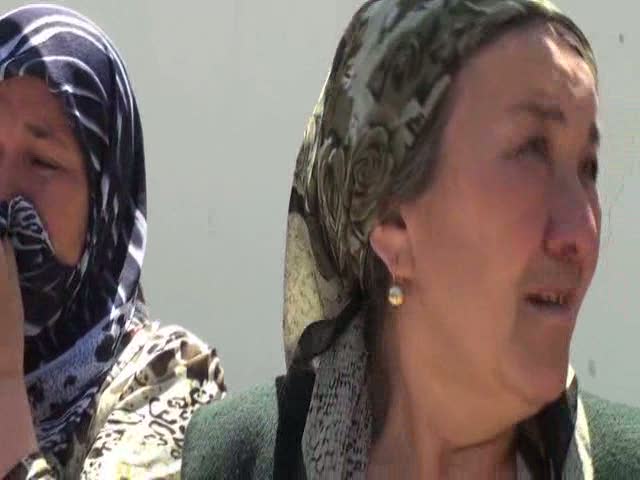Refugees Magazine Issue 104 (UNHCR's World) - Kyrgyzstan: On top of the world
Refugees Magazine, 1 June 1996
The day begins early for Sub-Office Head Franci Smailagic in Oshm Kyrgyzstan, in mountains that can take your breath away
By Franci Smailagic
UNHCR Sub-Office Head – Osh, Kyrgyzstan
3:45 a.m: The alarm clock goes off. Getting out of bed is tough, but is made a bit easier by the promise of an interesting day far from the office and its telephones, meetings and administrative tasks. A mug of strong coffee and I am all set.
As part of its preventive/early warning strategy in Central Asia, UNHCR opened two offices in Kyrgyzstan in October 1995. I am the only international staff-member in Kyrgyzstan's second city, Osh. UNHCR's main office is in the capital, Bishkek. In winter, we're cut off from each other for long periods when the snow blocks the high mountain passes.
For security reasons, my home and office are located in the same UNHCR compound in Osh. After the latest attempt to burgle and burn down the office, I begin each day warily. With a small CS tear-gas spray in my right hand, I enter the office and slowly check the premises. "Everything's OK," says the watchman. "It was a quiet night."
I proceed to the garage.The guard-dog was silent during the night. Nevertheless, I check the UNHCR vehicle carefully for strange wires and hidden objects, a habit I picked up while working in Bosnia and Tajikistan. It seems wise to continue the practice here in Osh. There is no war here, no terrorism; the authorities and most of the inhabitants are friendly and cooperative. But over the past few years, Osh has become one of the main distribution hubs on the new, blossoming northern drug-route from Afghanistan and other production centres in Central Asia. The drugs mafia is omnipotent and does not draw a distinction between UNHCR and UN-DCP [the U.N. Drug Control Programme]: in their eyes, we are all the enemy.
The vehicle does not seem to have been tampered with. However, an uneasy feeling persists as I turn the key in the ignition. When the engine has roared smoothly to life, I finally relax. At such moments I always ask myself whether I will ever again be able to start a car without a second thought – the result of a career in dangerous places.
I began my UNHCR life as a local staff-member in the northern Bosnian town of Banja Luka, which I had to leave in a hurry after receiving a tip-off that the repeated death-threats were about to become reality. In Tajikistan, where I spent two years, there were many tense moments and the field staff lived with strict security rules and curfews. If it weren't for the drugs mafia, and their inability to distinguish between different U.N. agencies, Osh would be far more relaxing than either of my previous postings. In many ways, it's a pleasant, lively, cheerful place, despite underlying tensions.
I leave the compound and drive through Osh. The city is dark and absolutely deserted. I pick up my driver, Erkin, and my assistant, Sasha. By 4:30 a.m. we are heading out of Osh towards the border with Tajikistan and China.
We are trying to check out unconfirmed reports that, due to the recent escalation in clashes between Tajik government and opposition forces in northern Tajikistan, sizeable numbers of people are leaving their homes and will try to cross the border into Kyrgyzstan. Kyrgyzstan already has some 30,000 Tajik refugees and others who left Tajikistan in the wake of the 1992 civil war.
The border region of Saritash is some 200 kms south of Osh. At one point, the road climbs to 3,600 metres. To watch the birth of a new day from a mountain this high is a breathtaking experience.
It takes us more than four hours to reach Saritash. At each of the nine checkpoints on the way, we are stopped by bleary-eyed militiamen. Explanations, document checks, puzzled looks and we are allowed to proceed.
When we finally reach Saritash, we are stopped at the main checkpoint, which is manned by the Russian Border Army. A Russian officer asks for instructions over the radio. After some time, we overhear the response crackling across the airwaves: "Let the U.N. proceed. We informed all posts of their presence in the area."
There are two roads into Tajikistan: one along the Garm Valley, via the town of Jirgital, the other through Gorno-Badakhshan to the towns of Murgab and Khorog. The Pamir mountain range, through which both roads pass, is one of the most spectacular regions in the world – in effect, the western tail of the Himalayas. Between the two roads soars 7,495-metre Mount Communism.
The Garm Valley has been closed to all traffic for four weeks, but the road to Murgab is open. The Russian border guard says he has not heard of any refugees arriving from Tajikistan. But there may be some "opposition terrorists" in the area, so be careful.
We take the Murgab road. It is only 45 kms to the border but it takes us two hours to get there. The road changes from bad to worse and is constantly climbing. Finally we reach the border, situated at 4,680 metres above sea-level. One last Russian Border Army checkpoint and we enter Tajikistan.
Two sleepy Tajik militiamen want to check our documents and search the vehicle. After learning we are with UNHCR – which is well-known in Tajikistan after a major three-year operation in the south-west of the country – they forget about searching the vehicle. Instead, they start claiming they are refugees too and ask for immediate help.
Soon we all are sitting in an old fuel tanker that has been converted into an office. Our canned fish and their tea combine to make a reasonable meal that helps stimulate the conversation. They inform us that the border is only open for people with a special permit. They have instructions not to let refugees enter Kyrgyzstan. There are numerous checkpoints on the road between here and Murgab – all of them supposed to prevent unauthorized movements. In the last couple of months, no would-be refugee had made it through to their checkpoint.
As we sat and talked with the Tajik militiamen, the weather was changing every few minutes. Sunny and warm one moment, sudden rain the next, then a strong, cold wind, then snow, then sun again. Four seasons in an hour. At an altitude of 4,680 metres, the air was thin and our lungs were suffering. I felt quite weak and my body was trembling.
The Russian Border Army and the Tajik militiamen had told us that these symptoms can be alleviated by vodka, hashish or something very sweet. We opted for something sweet – chocolate – but it did not help much. Judging by huge piles of empty vodka bottles surrounding the checkpoints, the soldiers usually opt for a different panacea.
We turn back and re-enter Kyrgyzstan. At the first checkpoint, a Russian soldier (who manages to hold onto a machine gun, an automatic assault-rifle, a pistol, half a dozen hand-grenades and a lot of ammunition while simultaneously checking our documents) tells us that he is very, very tired. No, it has nothing to do with carrying so many arms. He didn't sleep the previous night: problems on the Chinese border.
We head back towards Osh. I cannot help wondering how the Tajik refugees already in Kyrgyzstan managed to cross these huge and inhospitable mountains. How did they manage to pass these checkpoints? What happened between them and the militia? How did children and old people, hungry and thirsty, sick and tired, find enough strength to keep going? How many of them did not survive?
By the time we get back, Osh is dark and deserted again. I will take Sasha and Erkin home, but first we have to fill up the vehicle's petrol-tank and jerry-cans from our main storage tank. One of the basic rules says always leave the vehicle with a full tank overnight in case of emergencies.
The tank is full, Erkin and Sasha are safely at home and I am back in the office. On my desk, I spot a message from Aygul, our secretary, reminding me that tomorrow is the deadline for sending various administrative and financial documents to headquarters in Geneva. It also says there are unconfirmed rumours that due to fighting and unrest in various parts of Tajikistan, people are attempting to cross into Kyrgyzstan and Uzbekistan.
Saritash is not the only possible entry point. I make a quick decision. "HQ can wait," I think, as I pick up the walkie-talkie to call Sasha and Erkin and tell them I will pick them up early tomorrow morning. Sorry – later this morning. Tomorrow has already turned into today.
By mid-June, some 200-300 Tajiks (mostly of Kyrgyz origin) had arrived in Kyrgyzstan.
Source: Refugees Magazine issue 104 (1996)






